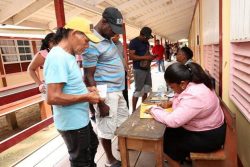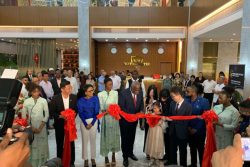Ambassador Byron Blake is former deputy permanent representative to the United Nations and former assistant secretary general of CARICOM.
Editor’s Note: A shorter version of this article appeared in the Jamaica Gleaner, December 8, 2024.
COP 29, formally the 29th United Nations Conference of the Parties on Climate Change, ended in Baku, Azerbaijan, on Sunday, November 24, 2024, two days after the scheduled closure with the clear verdict “Death to Planet Earth as an insurable, liveable Planet.” President Biden would say, “This is not hyperbole.”
While the Small Island Developing States (SIDS) and low-lying coastal States are the Canaries in the proverbial coal mine, the deleterious impacts are visible on all continents including Antarctica and in every region. In the words of Grenadian, Simon Stiell, the UN Climate Change Executive Secretary, “the UN Paris Agreement is humanity’s life raft.” The 2015 Paris Agreement set the limit for increases in average global temperatures above pre-industrial levels at 1.5 degrees Celsius. The seven years, 2018 to 2024, marked successively “the hottest year on record.” The increase in 2024 was 1.55, thus exceeding the limit of the Paris life raft.
The existential shortcoming of COP 28 was the failure to agree to phase out fossil fuels, the primary drivers of global warming. Yet this issue did not make it onto the agenda for COP 29. The feeble language achieved at COP 28 “to transition away from fossil fuels” was not reiterated. And, as if to add insult to injury, COP 29 finalised the Agreement on Carbon Markets which will allow countries to “legally” exceed their carbon emissions limit by buying “credits.” Put starkly, COP 29 prioritised the Carbon Market, a mechanism that will allow the overindulgent to give the poor some money to continue to poison them.
This should never have been allowed where the objective is to reduce total carbon emissions.
The UN Secretary-General has conceded that the 1.5-degree breach might well be permanent. The projections are for average annual increases to reach between 2.6 and 3.1 Degrees by 2050. To begin to imagine what such increases would mean for SIDS, we need only to recall the UN Secretary-General’s caution in his June 5, 2024, Environment Day message that “the difference between 1.5 and two degrees could be the difference between extinction and survival for some small island states and coastal communities.” He was speaking about 0.5, not the 1.1 or 1.6 degree difference between 1.5 and 2.6 or 1.5 and 3.1 Degrees Celsius. The likely impacts of these real prospects defy imagination.
Yet, in the face of such unimaginable prospects, the powers that control international decision-making deliberately and deceptively changed the agenda for COP 29 to avoid discussing actions to mitigate the rate of warming. They billed COP 29 as “the finance COP”. With financing such a long outstanding issue, the focus did not seem unreasonable to the unsuspecting. The endangered countries did not appreciate that, with the tipping point exceeded and the current projections, the time for financing to be effective had passed.
But, even if one conceded the finance focus, COP 29 was a dismal failure. The developing countries and the technical studies projected a need for 1.3 trillion United States dollars per year by 2035 to address the different aspects of the advancing climate crisis. After the extended negotiations and the intervention of G20 leaders who were meeting in Brazil, the COP agreed to provide a mere 300 billion United States Dollars, or approximately 25 per cent of the total needed.
The reports suggest that the developing countries, in particular the Alliance of Small Island States (AOSIS) and the Least Developed Countries (LDCS), negotiated strongly. The AOSIS and the LDCS might even have walked out of the negotiations at some point. Comments attributed to the Envoys of Bolivia and the Marshall Islands have been uncharacteristically blunt. The Marshall Islands Envoy has been quoted as saying “Fossil fuel interests have been determined to block progress. … This can never be allowed to happen.” But it happened. And the “paltry sum” to use the words of the Indian representative was accepted.
Representatives fell back on the unstated assumption of international conferences that chipping away at a problem, however slowly, signified progress. So, the Marshall Islands Envoy, in his frustration consoled himself with the words: we secured “something for our communities.” The operational word is “something.” The top UN bureaucrat, Secretary-General Antonio Guterres sought to console humanity with the words: “a base on which to build” was progress. They all fail to appreciate the qualitative difference between the problems of yesteryears and the challenge of global warming and climate change. The challenge here is not only that the problem is getting exponentially worse with time, but that it is lives, communities, societies, and economies that are being lost or radically transformed every passing day. A life lost today cannot be restored tomorrow.
Leaders of SIDS, Mr. Secretary General and Mr. Executive Secretary there is no time; the 1.5 Degree runway has been fully used. The Planet has been pushed over the edge. It is now to pick up the pieces, where that is still possible. Each year will be impossible or more expensive as the experience over the last 7 years has taught us.
There is another unsavoury aspect to consider concerning the “agreement” to provide finance. The Developed Countries, as a group, have never met 50 per cent of a financial commitment under any international agreement in support of developing countries. They failed to provide the 0.7 per cent of their Gross National Income (GNI) for Official Development Assistance (ODA) under the 1970 agreement; the 1992 RIO Agreement, reiterated in New York in 1997 and in Johannesburg in 2002 to increase their annual ODA contribution towards the 0.7 per cent as support for Climate Change; and the 2009 Copenhagen COP Agreement and reiterated in Paris in 2015 to provide US$100 billion to address global warming and Climate Change. That record must raise questions about the probability of compliance with this Baku Agreement. As in all the previous agreements, compliance is voluntary, there are no consequences for non-compliance and no designated debt collector. In the previous agreements responsibility for compliance rested solely with the Government and they did little. In this agreement, there is a large but unquantified expectation of the private
sector. Governments cannot hold the private sector responsible. There is thus no chance of compliance with the Baku agreement. The Developed Countries know that.
Developing countries including SIDS have lost on both fronts at COP 29. They are now at the mercy of a very disturbed Mother Nature. They can resign and await their fate or make a last collective stand. We suggest a last stand with COP 30 scheduled to be held in Belem, Brazil in late 2025. In this regard, they need to convey collectively, and as sub-groups and individual sovereign states, to the Government of Brazil, the Secretariat of the UN Framework Convention on Climate Change, and the Secretary General of the United Nations that unless it is pellucidly clear from the Agenda and the preparatory processes that the intended outcome will be agreed practical programmes with timelines, mechanisms, and resources to reverse the trajectory and achieve a return to average annual temperature increases of below 1.5 Degree Celsius above preindustrial levels by 2050, they will not participate in the COP. In addition, there should be agreement that the Outcome of COP 30 would include (1) a mechanism to collect outstanding and new financial commitments and (11) an arrangement to monitor the implementation of the agreed programme to 2050.
These preconditions must be conveyed before the planning process commences.
The SIDS will have to be resolute and press their case at every opportunity. The fact that Brazil will be the Chair of COP 30 cannot be relied on as providing home court advantage. The SIDS will do well to remind themselves that it was in RIO, Brazil in 2012 that the Developed Countries secured a movement from systematic 5- and 10-year reviews of the RIO Programme of Action.
The Developing countries should set themselves, and make public, a target date, perhaps the opening of the High-Level Segment of the UN General Assembly in September 2025, to determine whether sufficient progress has been made towards their objectives to warrant their participation in COP 30.










